Soul Calibur II
Rob's soul still burns!
The original Soul Calibur is, for the majority of the gaming public, probably the best beat 'em up they've never played. The sequel to the well-regarded PSone title Soul Edge, it remains to this day one of the most graphically stunning, finely balanced, accessible and engrossing fighting games ever created - but as fate would have it, Namco decided to release it exclusively on the Dreamcast, thus consigning it to being deservedly adored and championed by hardcore gamers, and almost entirely ignored by Joe Public.
Hoping that the same fate will not befall its sequel, Namco has decided to bring Soul Calibur II to every platform it could find - so if you go down to your friendly local retailer today, he'll be happy to furnish you with a version of the game for the GameCube, Xbox or PlayStation 2, whichever your poison may be. The differences between the versions are minor - but the real question is whether or not it can recapture the magic of the original? Is this worth developing a bad case of bleeding thumbs over? Does the soul still burn?
A Hero Seeks a Sword...
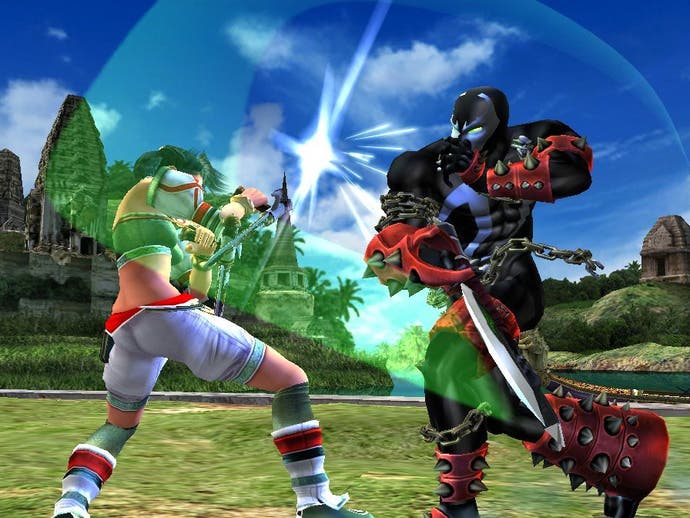
In case you've never played Soul Calibur, a brief run-down of how the game works is in order. This is a traditional enough 3D beat 'em up, complete with combos, throws, air juggles and all that guff - but everyone in it carries a bloody great sword (or other bladed or bludgeoning weapon of choice). It's not realistic in the slightest - those seeking Bushido Blade-style sword combat or breaking limbs and sprays of arterial blood will want to look elsewhere (like their local friendly psychiatrist, perhaps) - so as you chop away at your enemy, rather than filleting them up like a carcass in a butchershop, you're just knocking lumps off their health gauge. All very civilised, really.
So then, what set Soul Calibur apart from countless other beat 'em ups? On one level, it was the graphics; the visuals of the original Dreamcast game still look absolutely stunning, even now, and more impressive than the artwork was the animation, which gave every character a measure of graceful, flowing motion that you don't generally find outside the very best martial arts movies. On another level, it was the gameplay - which was not only supremely fast and dramatic, as you'd expect bladed combat between two people who really know their kung fu to be, but was also incredibly accessible for new players, while still containing enough subtlety to keep hardcore beat 'em up enthusiasts engrossed for months.
The sequel to the game, on first viewing, looks very similar to the Dreamcast original. Many of the characters from Soul Calibur return, and in some cases their moves are very similar - even down to using the same motion capture data for the animation, we suspect. Certainly, the game feels very familiar, and anyone who spent any time with Soul Calibur will have no difficulty getting to grips with their favourite characters in SCII. This isn't necessarily a bad thing; Namco has clearly realised that the basic gameplay of Soul Calibur wasn't broken, and opted not to fix it. What they have done, however, is added new layers to that gameplay in order to keep fans of the original engrossed without alienating new players.
A Tale of Souls and Swords
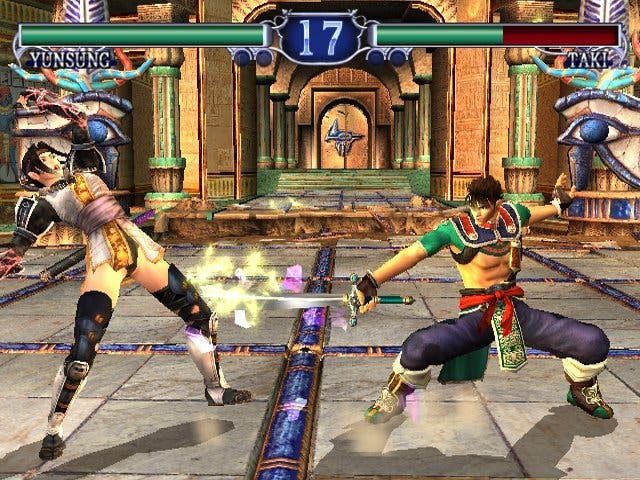
One new element, for example, is the weapon system in the game, with "Extra" modes that allow you to pick between different weapons for your character as well as choosing different costumes. Costumes just look pretty - weapons, however, actually make a slight difference to how the game plays, and while the default weapon for each character is arguably their most "balanced", unlocking new weapons does allow you to fine-tune the character to your favoured style of play. Of course, if you don't fancy having to learn playing styles for different weapons, you can just select Classic play modes which don't feature this functionality.
Another addition to the game is vastly overhauled quest mode, called Weapon Master, which forms the main single player element of the game. Compared with the wafer thin arcade modes on offer in other beat 'em ups (and also here, but only as one element of the game), this is practically an in-depth RPG - complete with a money system, an experience system, a branching path through the quest and a lengthy narrated plot. At each point in the plot you have to fight a battle under special circumstances - early examples being one where the wind pushes you off the edge of the arena, or where you have to land twenty hits on an opponent within twenty seconds.
These get gradually more difficult (and this is a beat 'em up that really does get tricky in places - even on Normal difficulty level there are few easy battles in SCII, and button bashing won't get you very far at all), but the difficulty curve is extremely well balanced and you'll find this mode to be a useful introduction to the subtleties of the game if nothing else. Plus, it's an extremely rewarding mode to play - not only does winning battles advance the story, but it unlocks new features in the main game, including new characters, costumes, weapons and "Museum" features (things like character martial arts exhibitions, production artwork, information about the various weapons and so on).
More Souls, Sir?
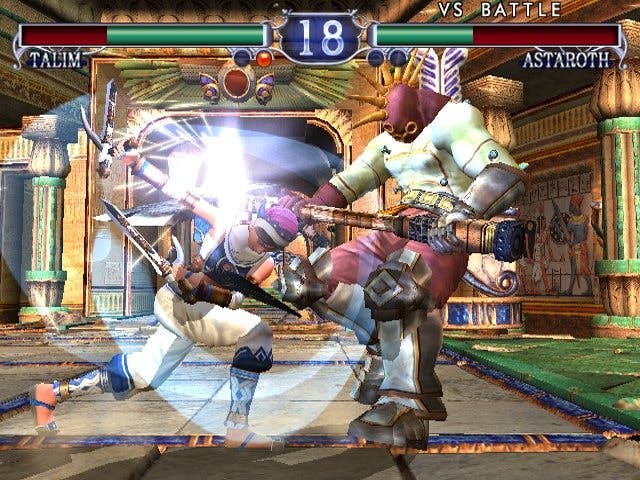
One element of Soul Calibur II, which has been the subject of significant discussion is the graphics, and we've seen quite a few people dismissively comment that they're no better than the Dreamcast version. There's a certain degree of rose tinted spectacles at work here - the Dreamcast version does still look fantastic, but placed side by side, the improvements of the new game are very obvious indeed. Background detail which was painted on in the original title is now fully rendered 3D, while the stages themselves are now incredibly detailed - witness some of the cobbled arenas where each cobble is an individual block rather than being drawn onto a texture, for example.
The fighters also look excellent, albeit rather different to how they looked in the original Soul Calibur - aside from the fact that they're all a few years older, they've also been given slightly less realistic, more anime-esque designs, which do admittedly take some getting used to. As you might expect, the animation is superb, right down to incidental detail like the hair and clothing flapping in the wind, or, in a move shamelessly copied from Dead or Alive, the supremely bouncy breasts. Yes, you heard me. It's a selling point, we suppose!
In terms of differences between the versions on the three platforms, Namco have actually done a remarkable job of keeping the graphical quality consistent without making the game feel like a lowest common denominator port. The PlayStation 2 version is certainly the weakest of the three versions graphically, but only to a trained eye, while the Xbox and GameCube versions look almost identical - and that's no bad thing, because even to an Xbox graphics whore, this is an incredibly good looking game, perhaps not quite on a par with Dead or Alive 3, but certainly in the same league.
Transcending History and the World...
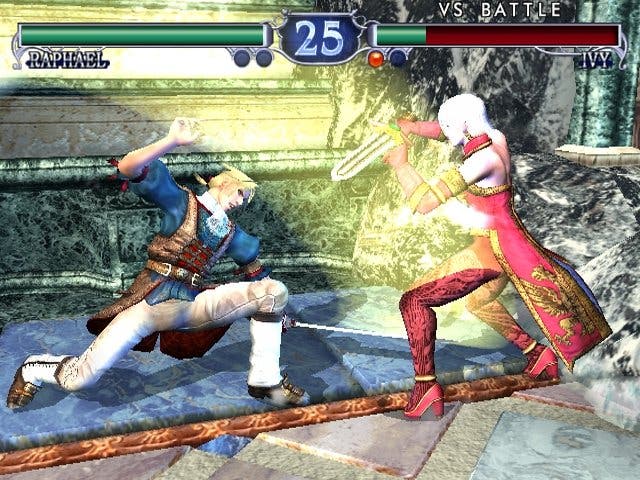
Of course, the real difference between the three versions lies in the platform-exclusive combatants, which have been added to all three alongside the main line-up of fighters. The PS2 version features Heihachi from Tekken; the Xbox version features Todd McFarlane's creation, Spawn (McFarlane also designed another character, Necrid, which is present in all three versions, and looks a bit rubbish to be honest); and the GameCube version features Link, complete not only with sword, shield and girly tights, but also with bombs, arrows and boomerang. All three characters actually work remarkably well in the context of the game, and don't feel unbalanced or out of place when squaring up against Soul Calibur's main cast. Our personal favourite by far is Link, whose long range attacks are excellent for taking newcomers by surprise - and besides, his extra weapons include a squeaky mallet and a fishing net. Who could resist?
The fact that Namco has managed to integrate these three unusual characters into Soul Calibur II without it feeling artificial or unbalanced is a testament to the care which has gone into making this a balanced game. Certainly, the characters all have different strengths and weaknesses, but over countless hours of playing the game in Versus mode, we've yet to find any one character that we'd describe as being massively overpowered or massively underpowered. We have our personal favourites, certainly, but no battle in Soul Calibur II is decided before the first sword flashes in the arena.
For newcomers, that's a reassuring start - and this remains the absolute ideal game for casual fans of beat 'em ups, who don't want to spend hours learning combo moves in order to get the most out of their game. It's possible to do incredibly impressive things in Soul Calibur II right from the start - which isn't to say that the game rewards button bashing, but rather that it's so well animated and it flows so well that even chaining together basic attacks can be hugely rewarding. It also feels far more natural than the majority of 3D beat 'em ups, with the moves on the joypad all corresponding in a logical fashion to what's happening on screen, and excellent usage of the 3D movement rather than trying to shoehorn 2D gameplay mechanics into a 3D environment.
Burning Down The House
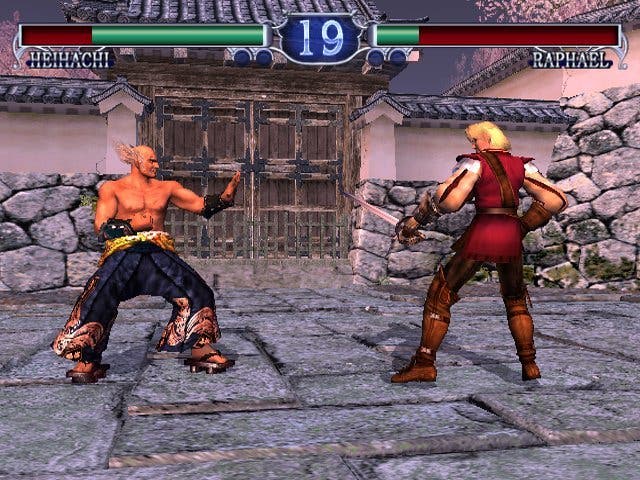
Soul Calibur II isn't without its faults, but thankfully they're quite minor. We noticed some quite annoying bugs in the PAL version of the game, such as the mislabelling of several weapons in the Weapons Gallery section of the Museum - a small problem, certainly, but one that makes it quite difficult to gauge the strengths of certain weapons. You'll also want to turn the English voice acting off as soon as possible - some characters are quite well done, but the excessively squeaky Xianghua, the incredibly fake sounding pseudo-English accent of Ivy and the downright diabolical Kilik were enough to have us giving thanks for the option to switch the voices back into Japanese, which is fundamentally a far better language for shouting death threats at people anyway.
Gaming purists will be pleased to find a 60Hz mode in the title, alongside widescreen and surround sound options (available in various flavours in all of the three versions), while CG fans might be interested to know that the stunning opening movie was nominated for a Best Of Show award at a prestigious graphics convention earlier this year. Those concerned about the longevity of a beat 'em up will be pleased to note that the Weapons Master section of the game is not only huge, but also almost infinitely replayable, while beating your best times in the arcade mode is also a surprisingly addictive pastime. Oh, and those who owned NTSC versions of the game might be interested to hear that the AI in the PAL version is significantly overhauled, and now presents far more of a challenge, even on Easy difficulty, than the pathetically easy AI opponents in the Japanese and American versions, with massively improved blocking, timing and counter-attacking skills.
The Soul Still Burns
For newcomers - people who didn't own a Dreamcast, or people who aren't massive fans of most beat 'em ups but can enjoy them on occasion - Soul Calibur II is a must-own, the absolute pinnacle of the casual fighting game. Hardcore beat 'em up gamers will have to make up their mind independently - everyone who's really into this genre has their own very personal ideas about what forms good gameplay, and Soul Calibur II might not conform to your ideas. The fact remains, however, that for the vast majority of the gaming world, this is quite easily the best 3D beat 'em up ever made.

